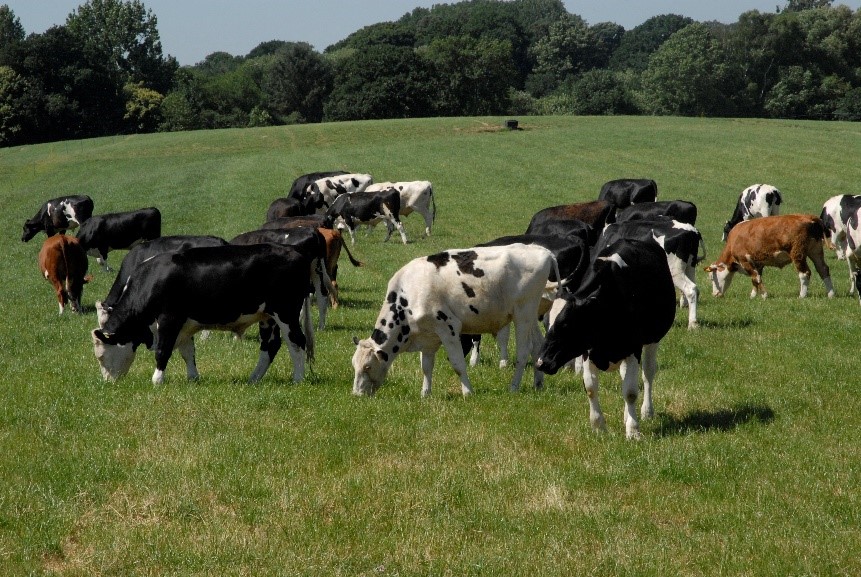- Home
- Knowledge library
- Grazing cover targets for rotational grazing cattle
Grazing cover targets for rotational grazing cattle
This section of our rotational grazing system series explores pre and post-grazing cover targets.
The type of stock and expected performance will govern the grazing targets throughout the season. Suckler cows are able to convert poor-quality forage into milk and therefore can be left to graze the poorer-quality swards and also graze residuals after priority stock, such as finishing cattle.
Pre- and post-grazing cover targets
Pre-grazing covers should be set at 2,500 to 3,000 kg/ha for all cattle over 8 months of age, with residuals being targeted at 1,500 kg DM/ha.
To achieve good growth rates of 1.1 kg/day across the grazing season high utilisation is essential.
If higher growth rates are expected, utilisation is likely to be reduced because the target residual of 1,500 kg/DM will not be achieved as grazing at this height reduces performance.
Suckler cows can be used to graze behind the finishing cattle to create a good residual which will help maintain the quality of grass for future rotations.
Paddock grazing targets
|
Stock type |
Pre-grazing target |
Post-grazing target |
Utilisation |
|
Cows and calves |
2,500–3,000 kg/ha |
1,500 kg/ha |
80% |
|
Growing and finishing stock |
2,500–3,000 kg/ha |
1,500–1,800 kg/ha |
60–80% |
|
Calves under 8 months old |
2,300–2,700 kg/ha |
1,800 kg/ha |
60% |
Generally, only dairy beef calves would graze on their own under 8 months of age. At this age, they have not adapted to graze high covers and are unable to graze down to a target residual of 1,500 kg DM/ha.
To achieve growth rates of 0.7 to 1 kg per day, entry covers should be reduced to 2,300 to 2,700 kg DM/ha, with an expected utilisation of 60%. Post-grazing residuals are likely to be 1,800 kg DM/ha.
Other stock, such as larger cattle or sheep, may be required to help clean out the sward after the calves have grazed.
Case study: Rotational grazing dairy beef calves
Harper Adams university demonstrate how their calves achieved 0.84 kg liveweight gain per day on grass alone.
 At Harper Adams University, 35 Friesian and 35 Hereford calves were purchased for a grazing and outwintering project being run jointly with ADAS and AHDB.
At Harper Adams University, 35 Friesian and 35 Hereford calves were purchased for a grazing and outwintering project being run jointly with ADAS and AHDB.
At turnout in March, the calves weighed, on average, 180 kg and were required to stay at grass until late October. With a potential intake of 5.5 kg DM per day, initially it was assumed the group would eat approx. 385 kg DM per day.
Initially, ten one-hectare paddocks were set up, on one large field, with temporary water being located centrally to provide water for four paddocks at the same time.
The paddocks could be split in two again to give 20 paddocks by allowing the calves to graze the nearer half to the water troughs first and then the far half after the temporary fence had been taken down.
The aim was to enter paddocks at 2,600 kg DM/ha and to graze down to a residual of 1,800 kg/DM/ha, accessing 800 kg DM/ha of available grass or just over two days per paddock.
With the grass growing at around 80 kg DM/ha in the spring, the paddocks were reduced to 0.5 hectares, with four hectares being cut for silage.
After silage was taken and the cattle were large enough to start hitting residuals, pre-grazing covers were increased to 2,800 kg DM/ha.
The paddocks were increased to one hectare again and the cattle were in each paddock for 2–2.5 days.
Due to the small intakes of the calves initially and the large spring growth, it’s important to be flexible and try to maintain grass quality through the season.
As the cattle grew, changes to paddock sizes and larger pre-grazing covers were manipulated to make the system work.
On a larger farm, other stock classes could have been used to manage the excess grass. Through the grazing season, the calves averaged 0.84 kg liveweight gain per day.

